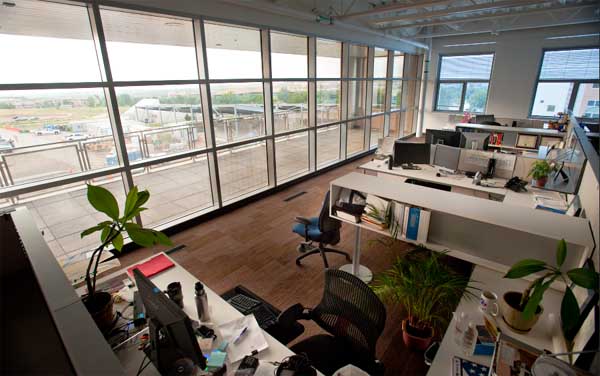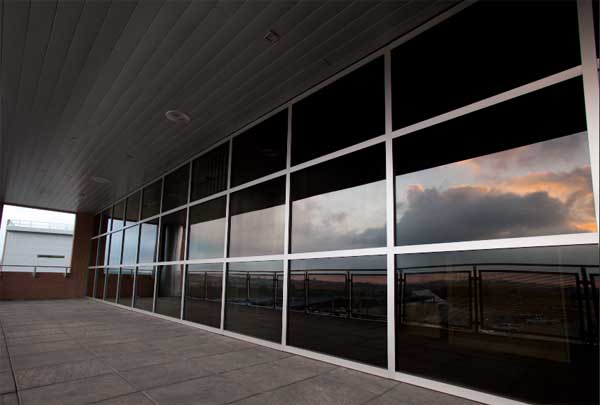Nary an article on a green building goes to press these days without mentioning the “extensive use of daylighting throughout.” That natural light is, of course, provided free-of-charge by the sun, via the many windows that architects are making sure to include as a strategy for reducing (or in some cases, even eliminating) the the need for electricity in illuminating a building’s interior during the day. And yet, all that glass tends to pour heat into a building during the summer months, requiring more juice to be expended in the form of AC.
Some strategies for reducing solar gain include windows equipped with low-emissions coatings (low-E windows), louvers or shades, and a relatively new (and relatively expensive) technology called electrochromic glass, which tints glass to block the sun’s rays at the touch of a button, or based on a pre-set program. But there’s a new kid on the block, which may just change the game when it comes to solar gain: RavenBrick’s thermochromic glass filters.

Because while electrochromic glass (as the name suggests) relies on electricity to get the job done, RavenBrick’s proprietary nanotechnology-based window filters are controlled by the very thing they were formulated to guard against: heat. Which means there are no wires or switches involved — and, as a consequence, considerably less expense. (Currently, electrochromic glass runs around $70 per square foot, while sandwiching RavenBrick’s RavenWindow filter between the two panes of glass in a standard Insulated Glass Unit [IGU] will only set you back around $16 per square foot.)
“We believe this technology is a game changer because it’s a technology that’s easily applied to the building industry as a whole,” Chris Ketchum, RavenBrick’s Vice President of Sales, told us in an interview. “We went into this market asking ourselves, can we make a product that’s not only energy efficient, but will pay for itself? That’s the difference between [what we offer] and other dynamic window technologies.” He goes on to note that RavenBrick’s filter technology is easy to apply to the window-manufacturing process and pays for itself in under five years.

(RavenBrick figures the return on investment [ROI] for each green building project based on the building’s current heating and cooling bills per square foot, using Lawrence Berkley Lab’s window software.)
And there’s more good ROI news on the horizon. RavenWindow technology is just about to become commercially available next year, which means that, as the demand for the product creates economies of scale, it’s liable to become cheaper still.
The originator of the nanotechnology used in the RavenWindow is a man named Will McCarthy — who is, among other things, an aerospace engineer, and the author of numerous books of science fiction and nonfiction (including Hacking Matter: Levitating Chairs, Quantum Mirages, and the Infinite Weirdness of Programmable Atoms) as well as RavenBrick’s co-founder, president and Chief Technology Officer.
Back in 2006, McCarthy was looking for funding for a heat-sensing technology he’d developed. Given his background, his first thought was to develop an application for the aerospace industry. He approached RavenBrick’s Chief Executive Officer Alex Burney, then a consultant, to help him secure that funding. It was Burney who pointed out that the aerospace industry’s turnaround time was so long it was likely that this promising technology would “die on the vine” before it came to fruition, and suggested that they would be better served by envisioning an application in the building sector. Within a week, the two had developed their first prototype idea for RavenWindow — basically, according to Ketchum, “by taking the parts out of a calculator.”

In 2007, McCarthy and Burney went on to found RavenBrick. By 2011, their technology had made its way into the National Renewable Energy Laboratory’s Research Support Facility in Denver, where RavenBrick is based. The company is entirely angel-funded, largely through green funds in the Aspen-Boulder area of Colorado.
While the company remains primarily focused on making good use of its intellectual property, RavenBrick expects to have its first manufacturing plant open by May of 2013. At that time, its proprietary RavenWindow filter will become commercially available to manufacturers of IGUs.
The RavenWindow filter (which enables windows to take on a tinted state when heated) represents the company’s most broad-based application of its tech, as it is a product with applications in both the commercial and residential market. But RavenBrick has also registered patents for a number of other applications, including a version of its filter capable of bringing windows into a mirrored state (for commercial buildings) and a version capable of bringing them into a white opaque state (for manufacturing facilities and warehouses).
“The dynamic window market [according to a recent poll] has been put at roughly a billion dollars in the next few years in North America,” Ketchum told us. “When we look at those numbers, we believe that they’re certainly doable. With the amount of glass and the amount of retrofitting and new construction that’s going on, there’s an enormous amount of opportunity for this kind of technology to get out there.” He goes on to point out that a commercial building retrofit using this technology can easily result in savings of upward of $150,000 a year, while increasing occupant comfort. “We believe it’s something building owners are going to want to take a look at.”
More on RavenBrick’s technology and its various applications are available online.